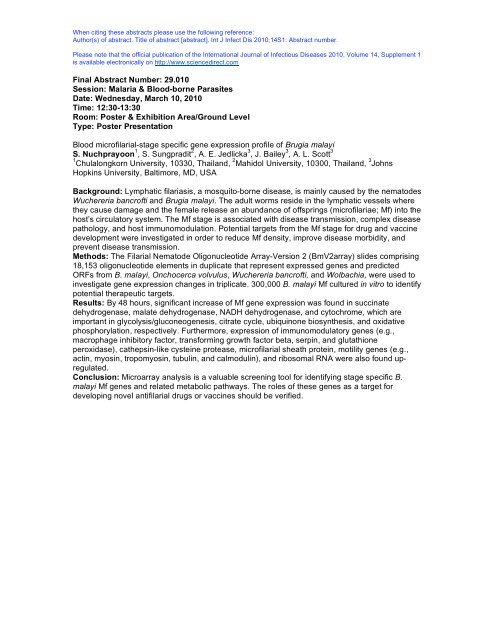14th ICID - Poster Abstracts - International Society for Infectious ...
14th ICID - Poster Abstracts - International Society for Infectious ...
14th ICID - Poster Abstracts - International Society for Infectious ...
Create successful ePaper yourself
Turn your PDF publications into a flip-book with our unique Google optimized e-Paper software.
When citing these abstracts please use the following reference:<br />
Author(s) of abstract. Title of abstract [abstract]. Int J Infect Dis 2010;14S1: Abstract number.<br />
Please note that the official publication of the <strong>International</strong> Journal of <strong>Infectious</strong> Diseases 2010, Volume 14, Supplement 1<br />
is available electronically on http://www.sciencedirect.com<br />
Final Abstract Number: 29.010<br />
Session: Malaria & Blood-borne Parasites<br />
Date: Wednesday, March 10, 2010<br />
Time: 12:30-13:30<br />
Room: <strong>Poster</strong> & Exhibition Area/Ground Level<br />
Type: <strong>Poster</strong> Presentation<br />
Blood microfilarial-stage specific gene expression profile of Brugia malayi<br />
S. Nuchprayoon 1 , S. Sungpradit 2 , A. E. Jedlicka 3 , J. Bailey 3 , A. L. Scott 3<br />
1 Chulalongkorn University, 10330, Thailand, 2 Mahidol University, 10300, Thailand, 3 Johns<br />
Hopkins University, Baltimore, MD, USA<br />
Background: Lymphatic filariasis, a mosquito-borne disease, is mainly caused by the nematodes<br />
Wuchereria bancrofti and Brugia malayi. The adult worms reside in the lymphatic vessels where<br />
they cause damage and the female release an abundance of offsprings (microfilariae; Mf) into the<br />
host’s circulatory system. The Mf stage is associated with disease transmission, complex disease<br />
pathology, and host immunomodulation. Potential targets from the Mf stage <strong>for</strong> drug and vaccine<br />
development were investigated in order to reduce Mf density, improve disease morbidity, and<br />
prevent disease transmission.<br />
Methods: The Filarial Nematode Oligonucleotide Array-Version 2 (BmV2array) slides comprising<br />
18,153 oligonucleotide elements in duplicate that represent expressed genes and predicted<br />
ORFs from B. malayi, Onchocerca volvulus, Wuchereria bancrofti, and Wolbachia, were used to<br />
investigate gene expression changes in triplicate. 300,000 B. malayi Mf cultured in vitro to identify<br />
potential therapeutic targets.<br />
Results: By 48 hours, significant increase of Mf gene expression was found in succinate<br />
dehydrogenase, malate dehydrogenase, NADH dehydrogenase, and cytochrome, which are<br />
important in glycolysis/gluconeogenesis, citrate cycle, ubiquinone biosynthesis, and oxidative<br />
phosphorylation, respectively. Furthermore, expression of immunomodulatory genes (e.g.,<br />
macrophage inhibitory factor, trans<strong>for</strong>ming growth factor beta, serpin, and glutathione<br />
peroxidase), cathepsin-like cysteine protease, microfilarial sheath protein, motility genes (e.g.,<br />
actin, myosin, tropomyosin, tubulin, and calmodulin), and ribosomal RNA were also found upregulated.<br />
Conclusion: Microarray analysis is a valuable screening tool <strong>for</strong> identifying stage specific B.<br />
malayi Mf genes and related metabolic pathways. The roles of these genes as a target <strong>for</strong><br />
developing novel antifilarial drugs or vaccines should be verified.
















